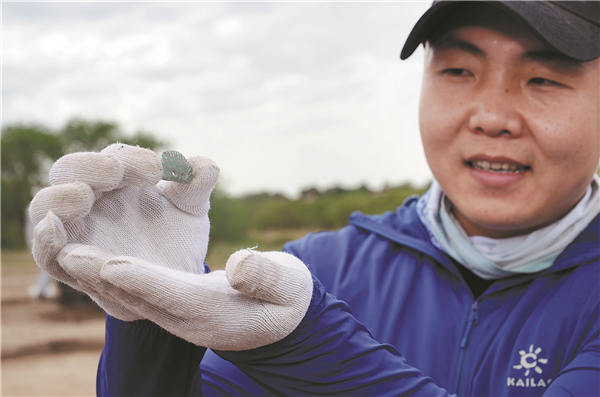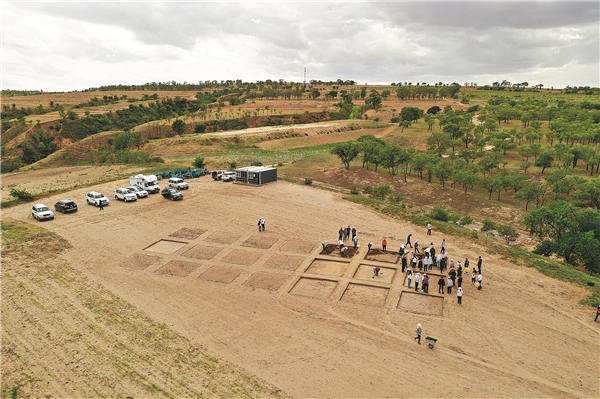DepthReading
Discoveries give researchers a clearer view into the past

For almost five decades, archaeologists have worked in the Aohan Banner in Chifeng, the Inner Mongolia autonomous region, and found more than 4,000 sites spanning from Neolithic times to the Bronze Age, which marks fruitful progress in prehistorical archaeological studies, according to Liu Guoxiang, a researcher with the Institute of Archaeology at the Chinese Academy of Social Sciences.
Based on the findings, they have identified a number of archaeological cultures, such as Xiaohexi Culture dating back more than 8,200 years, Xinglongwa Culture dating back 8,200 to 7,200 years, and Zhaobaogou Culture dating back between 7,200 and 6,400 years, forming a cultural sequence in the West Liaohe River basin, he adds.
"Four generations of archaeologists from the Institute of Archaeology at CASS have devoted a lifetime of effort to excavations in the Aohan Banner, and that has enabled us to see fruitful results," says Liu.
But he also points out they haven't excavated many settlement sites of the Lower Xiajiadian Culture, which dates back between 4,000 and 3,400 years. "We have found more than 2,400 sites of this culture, but only several of them have been systematically excavated. … As a result, there is a big missing link, meaning that our understanding of its cultural connotations is not clear enough. …That also influences our knowledge of the origin and formation of Chinese civilization," says Liu.
To fill in the blanks, a new archaeological project on the Xidaliang site in the Aohan Banner kicked off on July 5 and will run until October.
The site was discovered during the second national census of cultural relics in China in the 1980s, and was rechecked several times in recent years.
According to Liu, who is also head of the first Inner Mongolia working group under the Institute of Archaeology at CASS, which leads the excavation at the Xidaliang site, the institute has identified the site as a settlement of the Lower Xiajiadian Culture. It has been preserved relatively well with rich layered deposits. It covers an area of nearly 150,000 square meters and current conditions will allow for further excavation.
The excavation area is 500 sq m. As well as the first Inner Mongolia working group, the Inner Mongolia Academy of Cultural Relics and Archaeology, Chifeng University and Aohan Banner Museum are also participating in the excavation, according to Zhang Guochun, Party Secretary of the Institute of Archaeology of CASS.
During the archaeological survey process, before the excavation, researchers collected some artifacts from the surface of the site, like a jade decoration with patterns related to the sun, a stub of agate, and stone and bone arrowheads.

An attempt at innovation is the application of digital technology during the excavation. According to Liu, the institute is cooperating with a technology company in Beijing to develop an online system to record detailed information of each artifact that will be unearthed.
"A systematic and scientific excavation on the site is meaningful for studies on the type, specific time, features of settlement forms, settlement evolution, economy, development of handicraft, as well as the sacrificial and belief systems of this area of the Lower Xiajiadian Culture, and its cultural relationship with the Xia (c. 21st century-16th century BC) and Shang (c. 16th century-11th century BC) dynasties," Zhang said at a seminar introducing the excavation in Aohan Banner on July 6.
The site is located between Chengzishan and Yajishan, two important sites of Lower Xiajiadian Culture, which are both believed to be related to sacrifice. Xidaliang may have relations with them, and it seems they can be logically integrated, though further judgment is being withheld until after the excavation, says Liu.
Chengzishan is currently the largest, most complete sacrificial site of Lower Xiajiadian Culture in Northeast China with the clearest exposed relics and most complicated layout of the Bronze Age, says Liu.
He hopes that findings of the Xidaliang site will help build a national archaeological ruins park in the area, with the Chengzishan site as the center. "Our archaeological work today is not only for the benefit of academic research, but also to contribute to the social and economic development of the local area," says Liu.
Liu also mentions that some artifacts unearthed from the Dadianzi site in Aohan Banner, another Lower Xiajiadian Cultural site, are very similar to those unearthed from Erlitou site in Luoyang, Henan province, which is widely believed to have been the capital during the late period of the Xia Dynasty.
"Through excavations on such Lower Xiajiadian Cultural sites, we not only want to improve our knowledge of the local cultural sequence from Neolithic times to the Bronze Age, but also to carry out cultural comparison research to understand the diversified and integrated pattern of Chinese civilization during its origin and formation process," says Liu.
Category: English
DepthReading
Key words:
